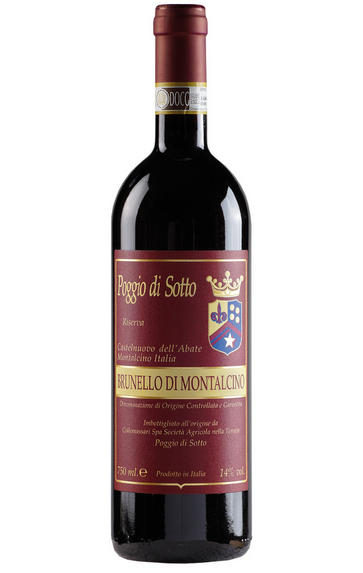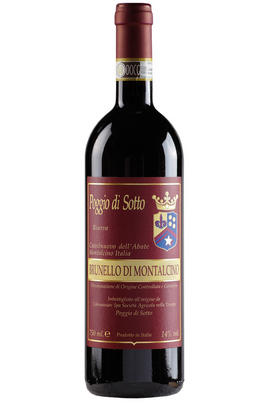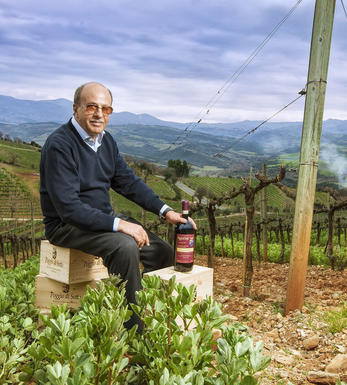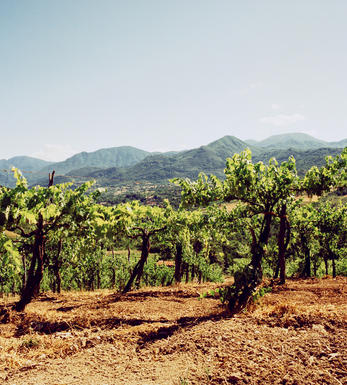
2015 Brunello di Montalcino, Riserva, Poggio di Sotto, Tuscany, Italy

Critics reviews
The Poggio di Sotto 2015 Brunello di Montalcino Riserva shows extra muscle definition, power and heady layers of rich fruit. This is all in line with the personality of the vintage, which was sunny and warm with golden sunlight throughout the summer season. This wine stands out for its fine-gained texture, which is smooth and polished. This Riserva offers aromas of cherry and blackberry and shows the depth that you should expect of a classic Riserva bottling.
These wines from Maria Iris and Claudio Tipa (of ColleMassari) renewed my faith in the enormous potential of Montalcino. I wrote about the "soul of Brunello" in my introductory article and played around with a definition of what that means.
You could read my words, or just pop your nose into a glass with any one of the wines reviewed here, and that spirit would be revealed to you. Not not only did these wines (particularly the Poggio di Sotto 2016 Brunello di Montalcino Riserva—a wine I can still taste in my mind) renew my faith, they sparked my passion. I can't wait to get back to Montalcino.
Poggio di Sotto is an estate that spares no expense (all the wines are now organic, and the estate has old vines up to 45 years old and is home to 120 biotypes of Sangiovese), so it would be rather tragic if the wines weren't so good. However, these are better than good. I think they are a new benchmark for the region.
Drink 2024 - 2050
Monica Larner, Wine Advocate (February 2022)
Poggio di Sotto’s Riserva is a cask selection that typically corresponds with the estate's oldest vines from its 20 hectares on the outskirts of Castelnuovo dell'Abate. Truly a bit muddled and wild at first, Poggio di Sotto’s Riserva eventually comes into handsome focus with fragrant pepper, strawberry and tea.
The palate takes on forest berry nuances along with an appealing twist of bitter roots and citrus peel, which make it all the more appetising. The tannins are graceful and accessible, but I would still give this a couple of years to sort itself out.
Drink 2023 - 2033
Michaela Morris, Decanter.com (March 2021)
About this WINE

Poggio di Sotto
Poggio di Sotto was founded in 1989 by Piero Palmucci, rapidly becoming known for benchmark, classical Brunello. Since 2011, it has been managed by the ColleMassari group and chief enologo, Luca Marrone. The wines are radical in style, challenging in youth but built to cellar. The estate is on the south-east extremities of the region. The vineyards perch above the Orcia river, in the shadow of Mount Amiata. The extinct volcano is often snowcapped, even in summer. Its cold winds soften the summer heat, bringing finesse to these wines.
The estate is split into three vineyards. The soils vary: the vines soak up mineral details from the rocky marl; marine-fossil-filled galestro; and the prized vineyards towards the top of the hill, which hold iron-rich clay.

Brunello di Montalcino
Along with Chianti, Brunello di Montalcino is Tuscany's most famous DOCG and the region's boldest expression of Sangiovese. Located 30 miles south of Siena with the hilltop town of Montalcino as its epicentre, its 2,000 hectares of vines are naturally delimited by the Orcia, Asso and Ombrone valleys. Brunello is the local name for the Sangiovese Grosso clone from which Brunello di Montalcino should be made in purezza (ie 100 percent).
The Brunello di Montalcino DOCG has a whale-like shape: at its head, at 661 metres above sea level on ancient, stony galestro soils facing east and southeast lies the town of Montalcino, where the DOC was founded. As you follow the spine south towards the tail, the vineyards lose altitude – those around Colle Sant'Angelo are at 250 metres – while the soils become richer with iron and clay. Further east, in the shadow of the 1,734 metre Mont'Amiata lies the village of Castelnuovo dell'Abate where the vineyards are strewn with a rich mix of galestro, granitic, volcanic, clay and schist soil types.
Historically, the zone is one of Tuscany's youngest. First praised in 1550 by Leandro Alberti for the quality of its wines, it was Tenuta Il Greppo who bottled the inaugural Brunello di Montalcino in 1888. By 1929, the region had 925 hectares of vines and 1,243 hectares of mixed crops, while in 1932 it was decreed that only those wines made and bottled within the commune could be labelled as Brunello di Montalcino. Since then, the number of producers has risen from 11 in 1960 to 230 in 2006, while over the same period the vineyards have expanded from 1,000 hectares to 12,000. The region earned its DOC in 1966, and was upgraded to DOCG in 1980.
Brunello di Montalcino cannot be released for sale until five years after the harvest, or six years in the case of Brunello di Montalcino Riserva. During this time the wines should be aged for at least two years in oak, followed by at least four months in bottle (six months for Riservas); maximum yields are 55 hl/ha.
Rosso di Montalcino is declassified Brunello di Montalcino, released for sale 18 months after the harvest.
Recommended producers: Costanti, Fuligni, Lisini, San Giuseppe, Soldera, Cerbaiona

Sangiovese
A black grape widely grown in Central Italy and the main component of Chianti and Vino Nobile di Montepulciano as well as being the sole permitted grape for the famed Brunello di Montalcino.
It is a high yielding, late ripening grape that performs best on well-drained calcareous soils on south-facing hillsides. For years it was blighted by poor clonal selection and massive overcropping - however since the 1980s the quality of Sangiovese-based wines has rocketed upwards and they are now some of the most sought after in the world.
It produces wines with pronounced tannins and acidity, though not always with great depth of colour, and its character can vary from farmyard/leather nuances through to essence of red cherries and plums. In the 1960s the advent of Super Tuscans saw bottlings of 100% Sangiovese wines, as well as the introduction of Sangiovese/Cabernet Sauvignon blends, the most famous being Tignanello.


Buying options
Add to wishlist
Description
Testament to Poggio di Sotto’s cooler microclimate, their Riserva is only 13% alcohol, a most elegant example of this ripe vintage. Low yields and strict selection mean only the best bunches make it. With spontaneous fermentation and 60 months in botti, this needs time. But it’s enjoyable and expressive now: gleaming and savoury, with smoky mineral grip.
Drink 2024 - 2042
wine at a glance
Delivery and quality guarantee